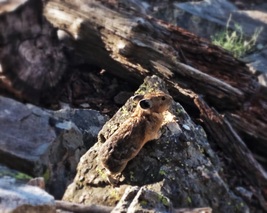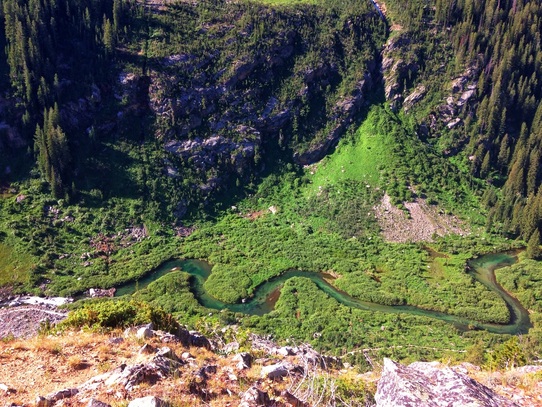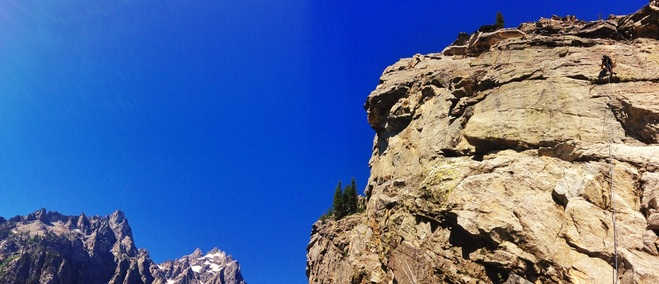By Dylan Jones
As we rounded the bend in the rocky trail, rock walls of gneiss and schist soared from the sagebrush meadows above us like magnificent giants guarding the pristine wilderness ahead.
Carrying a winter’s worth of precipitation over rocks and ledges, Death Canyon Creek drowned out most audible sounds, but above its thundering echo, we managed to pick up a recognizable “eeep.”
Could it be a pika?
My hiking partner Lauren grabbed her camera and snapped a photo before I spotted our target. Then I saw it, perched on a watermelon-sized chunk of brilliant white granite, alert. Its ears were pulled back, and its head and beady black eye turned toward us. It was aware of our presence long before we knew of it.
As we rounded the bend in the rocky trail, rock walls of gneiss and schist soared from the sagebrush meadows above us like magnificent giants guarding the pristine wilderness ahead.
Carrying a winter’s worth of precipitation over rocks and ledges, Death Canyon Creek drowned out most audible sounds, but above its thundering echo, we managed to pick up a recognizable “eeep.”
Could it be a pika?
My hiking partner Lauren grabbed her camera and snapped a photo before I spotted our target. Then I saw it, perched on a watermelon-sized chunk of brilliant white granite, alert. Its ears were pulled back, and its head and beady black eye turned toward us. It was aware of our presence long before we knew of it.
This was the first of many pika we observed in Death Canyon, a glacially-carved trough in Grand Teton National Park containing vast alpine talus fields where these important mammals squeak out a living.
Switchbacks gave way to numerous rock gardens as we climbed higher, where another pika squatted on a plum-colored boulder and a third chubby specimen darted into the dark catacombs beneath the talus. We hiked a total of eight miles that day before turning around, observing and noting the elevations of two more pikas.
Recording the observations with the iNaturalist app and viewing the photos added great joy to my hike that day. Accompanying the excitement of contributing credible data backed with photographic evidence came an overwhelming sense of attachment to the landscape.
That same week, a 7 a.m. boat ride across Jenny Lake and a strenuous hike up a climber’s trail in Cascade Canyon returned us to pika country once again. Diurnal feeders, pikas are active in the morning hours, and they made their presence well known as we scoped out a potential climbing route on Cascade’s vertical playground.
Recording the observations with the iNaturalist app and viewing the photos added great joy to my hike that day. Accompanying the excitement of contributing credible data backed with photographic evidence came an overwhelming sense of attachment to the landscape.
That same week, a 7 a.m. boat ride across Jenny Lake and a strenuous hike up a climber’s trail in Cascade Canyon returned us to pika country once again. Diurnal feeders, pikas are active in the morning hours, and they made their presence well known as we scoped out a potential climbing route on Cascade’s vertical playground.
I recorded observations for five pikas in just 20 yards of talus travel – the fourth being a friendly fellow that allowed me to get within four feet for a great photo. For me, the excitement that accompanied that day’s climbing adventure matched that of hitting the pika jackpot.
As we rappelled the route that afternoon, the sun bounced off the towering walls, like great mirrors reflecting the park’s unequivocal beauty. In the palm of geologic history, for a moment I felt part of something much larger than myself.
West Virginia native Dylan Jones grew up exploring the lush forests of Appalachia, where he gained a passion for conservation at an early age. He is currently a graduate student studying Environmental Policy and Public-Private partnerships in at West Virginia University, where in 2010 he earned a degree in Journalism. In his free time, Dylan rock climbs, mountain bikes, backpacks and snowboards.
Hiking or climbing in the alpine this summer? You can participate in the Worldwide Pika Project, which will contribute to understanding effects of climate change. Learn more on ASC’s Field Notes blog, Facebook, Twitter, Instagram and Google+.




